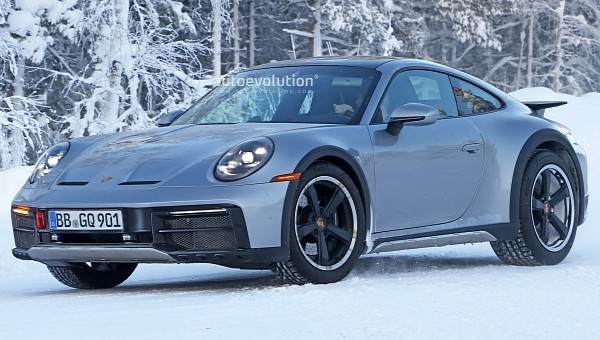Subsequent to the grand unveiling two months ago, the Porsche 911 Dakar has returned to the limelight, this time in a set of real-life images taken by our spy photographers in Europe.
Mind you, the Porsche 911 Dakar is a finished product, but it appears that it needs some last-minute adjustments, hence why the Zuffenhausen brand put one to the test recently in the cold. Or that’s what we think anyway.
Nonetheless, the reason behind unleashing it in the white stuff is not that important. What truly matters here is that it looks even better in real-life images than it does sitting under the spotlight at a car show, or in the official press pictures that accompanied the release late last fall.
Deemed by many enthusiasts as being the hottest 911 in decades, the new Porsche 911 Dakar has 2 inches (50 mm) more ground clearance than a stock AWD 911, and it can be further lifted by another 1.2 inches (30 mm) when engaging the off-road mode, available at speeds up to 105 mph (170 kph). A dedicated ‘Rally’ mode is also included. The car features black plastic cladding on the lower parts of the body that makes it look more utilitarian, and rides on 19-inch front and 20-inch rear wheels, wrapped in 245/45 and 295/40 Pirelli Scorpion all-terrain tires respectively.
It may be the hottest 911 in decades, but it is also one of the slowest, with a 150 mph (240 kph) electronically limited top speed. This was mandatory in order to preserve the meat on the tires. At least it is not slow to 60 mph (97 kph), with the sprint taking 3.2 seconds, according to Porsche. The 911 Dakar has four-wheel steering, dynamic engine mounts, and a curb weight of 3,552 pounds (1,611 kg). Power is supplied by the familiar twin-turbo 3.0-liter six-cylinder engine, which pushes out 473 hp (480 ps/353 kW) and 420 lb-ft (570 Nm) of torque. The thrust is directed to the all-wheel drive system via an eight-speed PDK transmission.
Anyone who can afford spending a couple hundred thousand dollars on a ride and has a soft spot for the 911 Dakar should go ahead and reserve a build slot while they still can, because production of the model will be capped at only 2,500 units. Pricing kicks off at $220,020, excluding the $1,450 destination charge, dealer fees, and options, which makes it a bit more expensive than a brand-new 911 Turbo S in the United States. It is likely that the jacked-up variant of the 911 will return for the next generation, even if the automaker hasn’t said anything about it, and it might eventually become a regular in the family, hopefully with a more affordable price tag attached to it.
Nonetheless, the reason behind unleashing it in the white stuff is not that important. What truly matters here is that it looks even better in real-life images than it does sitting under the spotlight at a car show, or in the official press pictures that accompanied the release late last fall.
Deemed by many enthusiasts as being the hottest 911 in decades, the new Porsche 911 Dakar has 2 inches (50 mm) more ground clearance than a stock AWD 911, and it can be further lifted by another 1.2 inches (30 mm) when engaging the off-road mode, available at speeds up to 105 mph (170 kph). A dedicated ‘Rally’ mode is also included. The car features black plastic cladding on the lower parts of the body that makes it look more utilitarian, and rides on 19-inch front and 20-inch rear wheels, wrapped in 245/45 and 295/40 Pirelli Scorpion all-terrain tires respectively.
It may be the hottest 911 in decades, but it is also one of the slowest, with a 150 mph (240 kph) electronically limited top speed. This was mandatory in order to preserve the meat on the tires. At least it is not slow to 60 mph (97 kph), with the sprint taking 3.2 seconds, according to Porsche. The 911 Dakar has four-wheel steering, dynamic engine mounts, and a curb weight of 3,552 pounds (1,611 kg). Power is supplied by the familiar twin-turbo 3.0-liter six-cylinder engine, which pushes out 473 hp (480 ps/353 kW) and 420 lb-ft (570 Nm) of torque. The thrust is directed to the all-wheel drive system via an eight-speed PDK transmission.
Anyone who can afford spending a couple hundred thousand dollars on a ride and has a soft spot for the 911 Dakar should go ahead and reserve a build slot while they still can, because production of the model will be capped at only 2,500 units. Pricing kicks off at $220,020, excluding the $1,450 destination charge, dealer fees, and options, which makes it a bit more expensive than a brand-new 911 Turbo S in the United States. It is likely that the jacked-up variant of the 911 will return for the next generation, even if the automaker hasn’t said anything about it, and it might eventually become a regular in the family, hopefully with a more affordable price tag attached to it.









